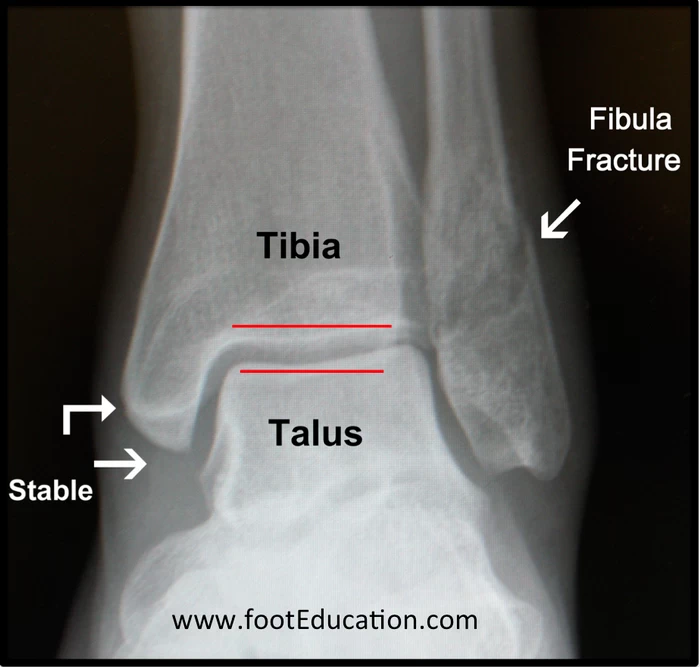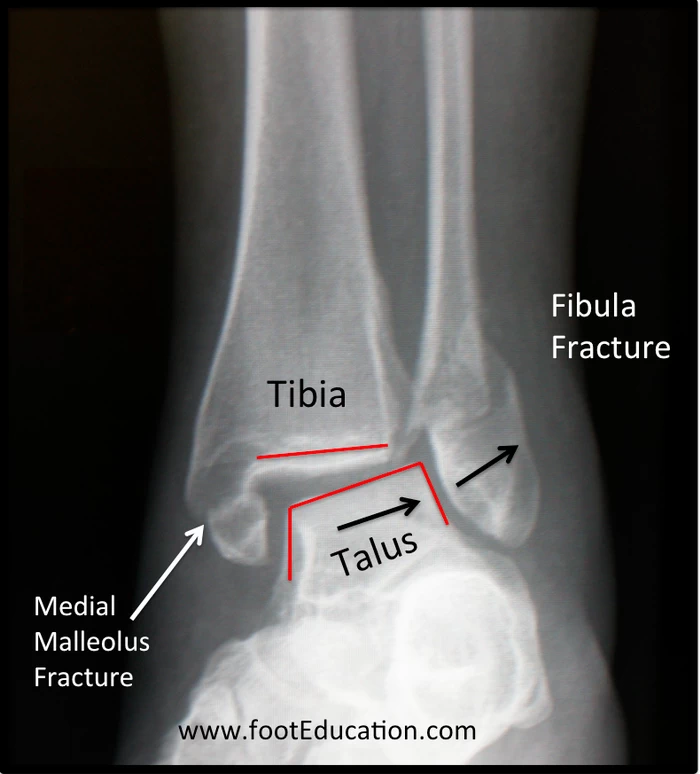Broken Ankle (Ankle Fracture 脚踝骨折
Broken ankles (脚踝骨折) can vary significantly in severity from a tiny crack in the bone to a large crack to multiple cracks. But even minor ones can immobilize (使无法动弹)you and require proper treatment to fully heal. This is important because a tiny misalignment (错位)now can lead to osteoarthritis (骨关节炎;[ˌɑːstioʊɑːrˈθraɪtɪs])down the road, making your joints stiff and limiting your range of motion. (from yalemedicine.org)
脚踝骨折的严重程度可以有很大的不同,从骨头上的一个小裂缝到一个大裂缝到多个裂缝。但即使是轻微的伤口也会使你无法动弹,需要适当的治疗才能完全愈合。这很重要,因为现在一个微小的错位会导致骨关节炎,使你的关节僵硬,限制你的活动范围。

The ankle joint is made up of three bones: the shin bone ( 胫骨 tibia), outer ankle bone (腓骨 fibula), and a bone in the foot between the leg and heel bones (距骨 talus). The ankle can fracture in more than one place, and the surrounding ligaments (which connect the bones to stabilize the joints) are also often damaged.
踝关节由三块骨头组成:胫骨(胫骨)、外踝骨(腓骨)和位于腿和跟骨之间的脚骨(距骨)。脚踝可能不止一个地方骨折,周围的韧带(连接骨头以稳定关节)也经常受损。

Many fibula fractures may require wearing a walking boot or cast (石膏) for a period of time, whereas most tibia fractures need surgery. When both the tibia and fibula are fractured, or the joint is shifted or dislocated, surgery is usually the best option. (from yalemedicine.org)
许多腓骨骨折可能需要穿步行靴或石膏一段时间,而大多数胫骨骨折需要手术。当胫骨和腓骨都骨折,或者关节移位或脱位时,手术通常是最好的选择。
What are the symptoms of a broken ankle? 脚踝骨折有什么症状?
If you fractured your ankle, you will likely experience immediate, sharp pain and possible swelling.
如果你的脚踝骨折了,你可能会立即感到剧痛,并可能肿胀
Additional symptoms include: 其他症状包括:
Pain that spreads throughout the foot and up your leg, toward your knee
Intensifying pain if you try to bear weight on your foot
Bruising or discoloration
Dislocation 脱位 (the ankle appears bent, distorted, rotated, or out of place) (from yalemedicine.org)
疼痛会蔓延到整个脚部和腿部,一直到膝盖
如果你试图用脚承重,疼痛会加剧
瘀伤或变色
脱位(踝关节出现弯曲、扭曲、旋转或错位)
How is an ankle fracture diagnosed? 如何诊断踝关节骨折?
If you suspect you have fractured your ankle, your doctor will first ask you to describe what happened. Next, your doctor will perform a physical examination (身体检查).
如果你怀疑你的脚踝骨折了,你的医生会首先让你描述发生了什么。接下来,你的医生会给你做身体检查。
Check for damage to blood vessels near the ankle (by taking your pulse at the top of the foot and examining skin temperature and color)
Check for nerve damage (by assessing sensation) near the ankle
Gently move the ankle to see where the pain is and check range of motion
Examine the joints above and below the injured area
Often, a severe sprain and a fracture cannot be seen without an X-ray. An X-ray can show the precise fracture location and provide information that allows your doctor to identify the best treatment. For large fractures or ones that involve ligaments, your doctor may order more detailed image studies, including a CT (computed tomography) scan or MRI ((磁共振成像 magnetic resonance imaging). (from yalemedicine.org)
检查脚踝附近的血管是否受损(通过在脚尖处测量脉搏,检查皮肤温度和颜色)
检查脚踝附近的神经损伤(通过评估感觉)
轻轻地移动脚踝,看看疼痛在哪里,并检查活动范围
检查受伤部位上下的关节
通常,如果没有x光片,严重的扭伤和骨折是看不出来的。x光片可以显示骨折的精确位置,并提供信息,让医生确定最佳治疗方案。对于较大的骨折或涉及韧带的骨折,医生可能会要求进行更详细的图像研究,包括CT(计算机断层扫描)或MRI(磁共振成像)。
How is an ankle fracture treated? 如何治疗脚踝骨折?
Depending on the severity of your ankle fracture (脚踝骨折), your treatment may be nonsurgical (非手术)or surgical (手术).
根据你脚踝骨折的严重程度,你的治疗可以是非手术或手术。
Nonsurgical 非手术治疗
For a simple break in one bone that is stable, your doctor may recommend using a walking boot or cast for about six weeks to protect the fracture as it heals. Depending on which bone is broken—and where the break is on the bone—you may be able to put some weight on the affected leg right away or you may need to use crutches for a few weeks.
对于一根稳定的骨头的简单骨折,你的医生可能会建议使用步行靴或石膏约六周,以保护骨折愈合。根据骨折的部位和骨折部位的不同,你可能需要在受伤的腿上立即施加一些重量,或者你可能需要使用拐杖几个星期。
Additional recommendations for mild fractures, especially in the first few days following injury, include:
对于轻度骨折,特别是受伤后的头几天,其他建议包括:
Resting the ankle
Elevating the ankle (above the heart)
Icing the area every one to two hours for 15 minutes at a time
Your doctor will have you come in regularly to have X-rays to check that the fracture fragments haven’t misaligned as they heal. Additionally, medications such as acetaminophen (Tylenol) and ibuprofen (Motrin) may help with pain and inflammation. (from yalemedicine.org)
脚踝休息
抬高脚踝(高于心脏)
每隔一到两个小时给该区域结冰15分钟
你的医生会让你定期来做x光检查骨折碎片在愈合过程中没有错位。此外,对乙酰氨基酚(泰诺)和布洛芬(布洛芬)等药物可能有助于缓解疼痛和炎症。
Surgical 手术治疗
For more serious fractures, including cases where the bones, and in particular the joints, are misaligned from the break, surgery may be necessary.
对于更严重的骨折,包括骨头,特别是关节,与骨折错位的情况,手术可能是必要的。
In many cases, your surgeon will reposition any bone fragments (骨碎片)into their normal alignment and hold them together with special screws and metal plates to keep the fragments together while you heal. Sometimes, bone grafting (骨移植) (transplanting bone tissue) may be done so that new bone has a place to grow. (from yalemedicine.org)
在许多情况下,你的外科医生会将任何骨碎片重新定位到正常的位置,并用特殊的螺钉和金属板将它们固定在一起,在你愈合的过程中保持碎片在一起。有时,可以进行骨移植(移植骨组织),以便新骨有生长的地方。
After surgery, your ankle should be as strong as it was before the fracture. But if the bone fragments do not remain in place, you may fracture your ankle again or arthritis (关节炎) could develop. (from yalemedicine.org)
手术后,你的脚踝应该和骨折前一样强壮。但是,如果骨头碎片不能留在原位,你可能会再次骨折或患上关节炎。

